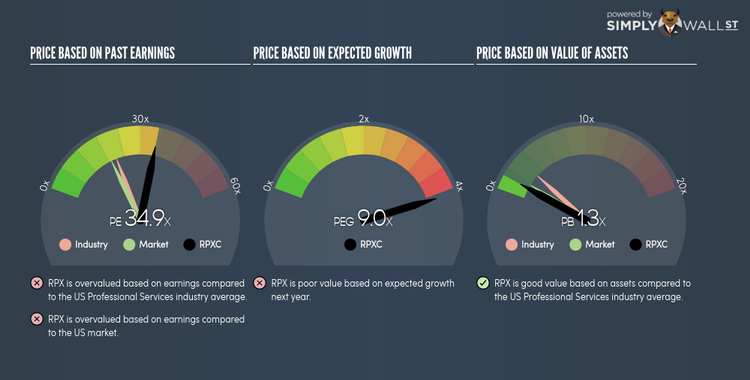Does RPX Corporation’s (NASDAQ:RPXC) PE Ratio Signal A Selling Opportunity?

RPX Corporation (NASDAQ:RPXC) trades with a trailing P/E of 34.9x, which is higher than the industry average of 20.9x. While this makes RPXC appear like a stock to avoid or sell if you own it, you might change your mind after I explain the assumptions behind the P/E ratio. In this article, I will deconstruct the P/E ratio and highlight what you need to be careful of when using the P/E ratio. View our latest analysis for RPX
Breaking down the P/E ratio
P/E is often used for relative valuation since earnings power is a chief driver of investment value. By comparing a stock’s price per share to its earnings per share, we are able to see how much investors are paying for each dollar of the company’s earnings.
P/E Calculation for RPXC
Price-Earnings Ratio = Price per share ÷ Earnings per share
RPXC Price-Earnings Ratio = $13 ÷ $0.372 = 34.9x
The P/E ratio itself doesn’t tell you a lot; however, it becomes very insightful when you compare it with other similar companies. We preferably want to compare the stock’s P/E ratio to the average of companies that have similar features to RPXC, such as capital structure and profitability. A quick method of creating a peer group is to use companies in the same industry, which is what I will do. At 34.9x, RPXC’s P/E is higher than its industry peers (20.9x). This implies that investors are overvaluing each dollar of RPXC’s earnings. As such, our analysis shows that RPXC represents an over-priced stock.
Assumptions to be aware of
However, before you rush out to sell your RPXC shares, it is important to note that this conclusion is based on two key assumptions. Firstly, our peer group contains companies that are similar to RPXC. If this isn’t the case, the difference in P/E could be due to other factors. For example, if you compared higher growth firms with RPXC, then its P/E would naturally be lower since investors would reward its peers’ higher growth with a higher price. The second assumption that must hold true is that the stocks we are comparing RPXC to are fairly valued by the market. If this does not hold, there is a possibility that RPXC’s P/E is lower because our peer group is overvalued by the market.
To help readers see pass the short term volatility of the financial market, we aim to bring you a long-term focused research analysis purely driven by fundamental data. Note that our analysis does not factor in the latest price sensitive company announcements.
The author is an independent contributor and at the time of publication had no position in the stocks mentioned.

